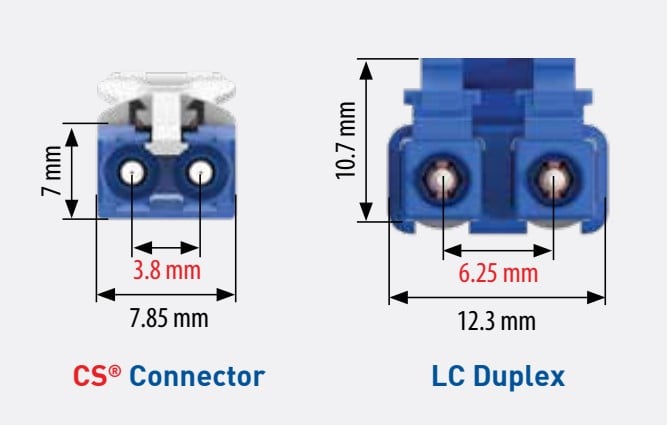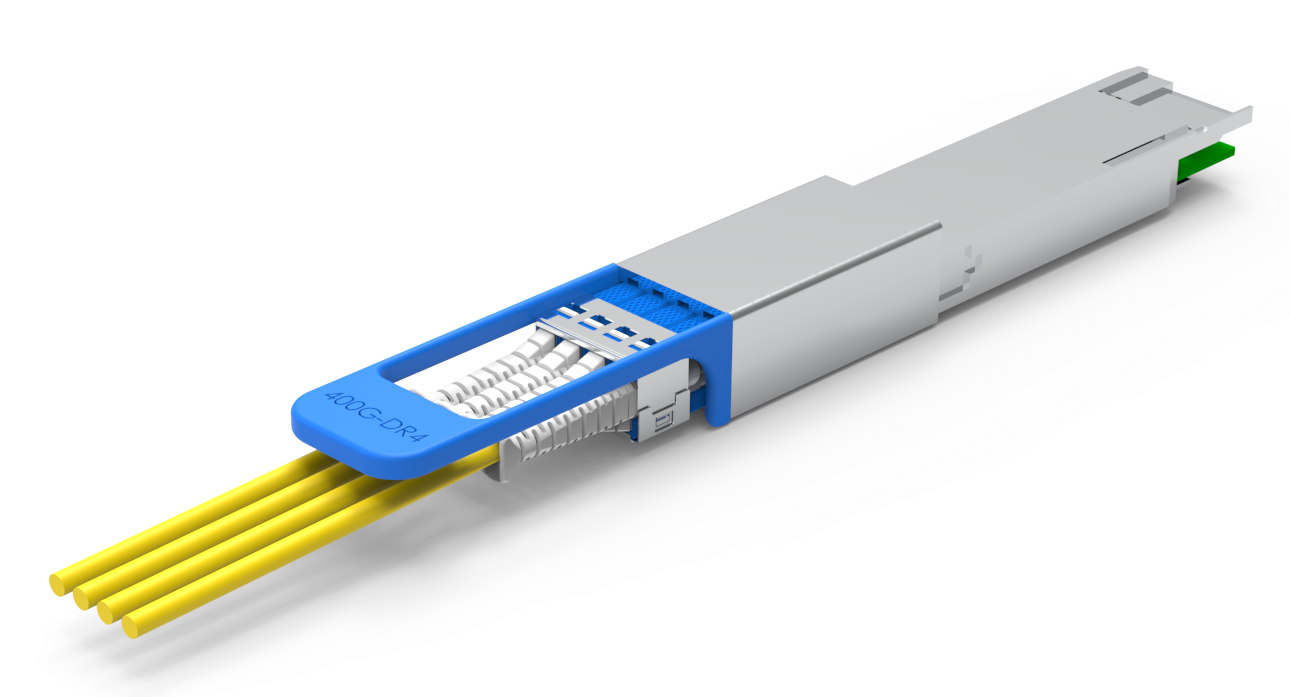关于 VSFF 连接器你应该了解的内容
2025 年 5 月 27 日 / 常规、安装与测试、最佳实践
随着数据中心装入更多服务器、交换机和存储设备以处理海量数据以及人工智能等新兴的高性能计算 (HPC) 应用(这些应用的集群可能包含数百甚至数千个相互连接的图形处理单元 (GPU)),光纤密度正急剧增加。新型超小型 (VSFF) 连接器正崭露头角,有望在高密度环境中极大地优化空间利用,成为改变格局的关键因素。让我们来看看这些 VSFF 连接器与传统光纤连接器有何不同,以及它们的各种应用场景。

VSFF 连接器专为提高密度而设计
如今的光纤技术人员对双工连接器很熟悉,比如 2.5 毫米的 SC、ST 和 FC 光纤连接器,以及广泛使用的 1.25 毫米小型 LC 连接器。在数据中心工作的人员还会使用多芯推拉式 (MPO) 连接器,这种连接器将多根光纤捆绑在一起,用于高速并行光应用。
但随着数据中心的复杂性和密度不断增加,传统连接器难以满足需求。VSFF 连接器应运而生,它在密集的基础设施环境中可大幅节省空间。VSFF 连接器是下一代光纤技术。此款连接器经过精心设计,旨在为 QSFP-DD 和 OSFP 等现代收发器实现端口密度最大化。在过去几年里,市场上出现了多种 VSFF 连接器,包括 CS、SN 和 MDC 双工连接器,以及 SN-MT 和 MMC 多纤连接器。让我们来看看这些不同类型的连接器。
CS 双工连接器:小尺寸,高性能
由 Senko 在 2018 年推出的双工 CS 连接器,其密度比 LC 连接器高 40%。CS 连接器与 LC 连接器一样采用经过验证的 1.25 毫米插芯,但两根光纤的间距仅为 3.8 毫米,而 LC 连接器为 6.25 毫米。更小的间距使 CS 连接器的整体尺寸为 7.85 毫米 × 5.3 毫米,相比之下,LC 连接器为 13 毫米 × 10.7 毫米。为了让你直观感受尺寸差异,CS 连接器在 1U 配线架中可容纳 144 个双工端口,而最高密度的 LC 配线架仅支持 96 个双工端口。

VSFF CS 双工连接器比 LC 双工连接器小 40%。
CS 连接器的主要特点:
- • 推拉式拉片,便于插拔
- • 有 UPC 和 APC 两种类型,适用于多模和单模光纤
- • 低损耗单模和多模光纤的最大插入损耗为 0.15 分贝
- • 通过 QSFP-DD 模块中的双 CS 配置支持 400G 双波分复用 (WDM) 应用
CS 连接器主要设计用于在 QSFP-DD 收发模块中容纳两个 CS 连接器。一个 QSFP-DD 模块只能容纳一个 LC 连接器,这就限制了 LC 连接器只能用于单波分复用 (WDM) 应用。使用双工 LC 连接器实现 400 吉比特传输,需要每根光纤使用 8 个波长(每个波长的传输或接收速率为 50 Gb/s),这会增加收发器成本。
相比之下,一个 QSFP-DD 模块中的两个双工 CS 连接器(称为双 CS)支持双 WDM 400 吉比特应用(2×200 吉比特),每根光纤使用 4 个波长,从而降低了收发器成本,并提高了交换机端口密度。Senko 对 CS 连接器进行授权,所以你可能会在电缆和连接设备制造商处看到这种连接器。

两个 VSFF CS 双工连接器可装入一个 QSFP-DD 收发器,从而减少波长数量并降低成本。来源:Senko。
SN 双工连接器:针对超大规模互连进行优化
最近,Senko 推出了 SN VSFF 双工连接器,以满足数据中心不断提高的速度要求并进一步降低成本。SN 连接器主要为满足苛刻的超大规模数据中心互连需求而设计,它采用经过验证的 1.25 毫米插芯技术,但光纤垂直间距仅为 3.1 毫米,将连接器宽度缩小至 3.85 毫米,密度达到 LC 连接器的 3 倍。

VSFF SN 双工连接器将光纤垂直排列,大幅减小了连接器宽度。来源:Senko。
SN 连接器的主要特点:
- • 每个 QSFP-DD 模块可容纳 4 个 SN 连接器
- • 非常适合从单个 400G 端口分出 4×100G 链路
- • 无需扇出电缆或转接盒
- • 采用与 1.25 毫米插芯配套的推拉式保护套
SN 连接器设计用于在 QSFP-DD 收发器中容纳四个连接器,非常适合从 8 光纤应用过渡到双工应用(如 4×100 吉比特分路部署)。与 CS 连接器一样,SN 连接器也有便于插拔的推拉式拉片,插入损耗低,并且可授权给电缆和连接设备制造商。

在单个收发器中装入四个 SN 双工连接器是分路应用中具有成本效益的选择。来源:Senko。
MDC 双工连接器:具有竞争力的选择
数据中心行业的技术发展带来了竞争,因此 US Conec 也推出了一款 VSFF 双工连接器——MDC(迷你双工连接器),这并不令人意外。MDC 连接器比 SN 连接器略小,同样采用经过验证的 1.25 毫米插芯,光纤垂直排列。然而,MDC 和 SN 连接器不兼容,请勿将它们插入对方的收发器接口或配线架端口。

US Conec 的 MDC 双工连接器比 SN 连接器略小,可装入单个收发器,为分路应用提供了另一种选择。来源:US Conec。
MDC 连接器的主要特点:
- • 单个 QSFP-DD 模块可容纳四个 MDC 连接器
- • 在超大规模数据中心部署中可与 SN 连接器直接竞争
- • 授权给电缆制造商,类似于 MTP(其 MPO 版本)
- • 与 SN 连接器不交叉兼容
多纤 VSFF 连接器:SN-MT 和 MMC
超高速 800 吉比特并行光纤应用使用 16 光纤 MPO 连接器 (MPO-16),其中 8 根光纤用于发送,8 根光纤用于接收,每通道速率为 100 Gb/s。传统的 MPO-16 连接器将 16 根光纤集中排列成一行,两根定位销之间的间距为 5.3 毫米。整个连接器尺寸为 12.4 毫米 ×8.2 毫米,大约可在 1U 配线架中容纳 80 个 MPO-16 连接器。对于未来的 1.6 太比特应用,该解决方案使用双 MPO-16 连接器,以确保每根光纤速率为 100 Gb/s 时通道的完整性。
为满足当下和未来对密度的需求,Senko 和 US Conec 都推出了 VSFF 16 光纤连接器:
- • SN-MT,基于 Senko 的 SN 外形规格,有 8 光纤和 16 光纤两种类型
- • MMC,US Conec 的产品,有 12 光纤、16 光纤和 24 光纤几种类型
- • 这两种连接器都使用定位销进行对准,并采用便于操作的推拉式保护套
这些连接器都采用与双工 SN 和 MDC 连接器相同的垂直堆叠方式,减小了连接器外壳宽度,密度达到传统 MPO 连接器的近三倍。为了直观体现尺寸差异,216 个 SN-MT 或 MMC 连接器占用的空间与 80 个传统 MPO-16 连接器相同。

新型 VSFF 16 光纤 MPO 连接器的尺寸仅约为传统 16 光纤 MPO 连接器的三分之一,在高性能计算 MPO 连接器结构中可提升密度。来源:Senko 和 US Conec。
超大规模数据中心设备供应商和交换机制造商已在开发带有可插拔收发器的交换机,这些收发器适用于 SN-MT 和 MMC 连接器,以满足高性能计算 (HPC) 应用的需求。SN-MT 和 MMC 连接器尺寸较小,使得将预端接主干线缆穿过通道更加容易。SN-MT 和 MMC 连接器也是板载光模块和共封装光模块中理想的板装连接器,这些光模块可使电光转换过程更接近交换机的应用微芯片。
如何测试 VSFF 连接器
虽然大型超大规模数据中心和云数据中心才刚刚开始在高速互连和高性能计算环境中使用 VSFF 连接器,但随着更多数据中心向 800 吉比特迁移,未来十年内其应用可能会增加。Fluke Networks 正关注这些新型连接器的市场应用情况,并将为我们的光纤测试和认证解决方案开发 VSFF 接口以满足需求。此类解决方案将采用单跳线参考方式,这种方式在测量中产生的不确定性最小。
同时,测试跳接线或已安装线缆上的 VSFF 连接器可能需要采用三跳线法,即在被测线缆两侧使用分路测试参考线。欲了解详情,请查看 Fluke Networks 知识库中关于使用三跳线法测试双工 VSFF 连接器的内容。
目前,测试多纤 SN-MT 或 MMC 连接器也需要采用三跳线法,使用 Y 型分路电缆,根据连接器类型的不同,一端为 16 光纤或 24 光纤 VSFF 连接器,另一端为两个 8 光纤或 12 光纤 MPO 连接器。在这种情况下,需要对两条支路分别进行测试并将结果相加,以测试链路的总损耗。
VSFF 连接器测试帮助
如果你在使用 VSFF 连接器且不确定如何进行测试,Fluke 技术支持中心 (TAC) 的专家可以提供帮助。他们将帮助你确定适合你应用的正确光纤测试解决方案和测试方法。




